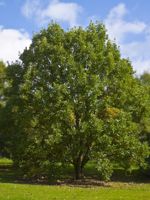Mon-Fri 9am - 5pm Mountain time
Wayfaring Tree vs Schuettes Oak
Viburnum lantana
Quercus × schuettei (Quercus bicolor × Quercus macrocarpa)
CUSTOM GROW
NOT AVAILABLE THIS SEASON - MIGHT RETURN
Wayfaring Tree is an adaptable and reliable shrub. It is prized for its ornamental berries that can range in color from red to yellow to black. Consider getting two trees as fruiting is maximized when another Wayfaring Tree is present.
This species has a variety of uses ranging from naturalization, mass planting, borders, and privacy screens.
Schuettes Oak is a naturally occurring hybrid of Swamp White Oak and Bur Oak. With a faster growth than both parent species, it is one of the fastest growing Oak trees. They are known for growing very large and wide, so space them appropriately. It is considered one of the most adaptable Oaks with little preference on soil conditions. It can handle growing in wet, saturated soils as well as those that are dry, clay, or alkaline.
The Schuettes Oak has very large acorns. They have a large cup portion like the Bur Oak, but without the fringe. Due to the Swamp White Oak parentage, the acorns have less tannins and a sweeter taste. They are a food source for various wildlife including birds, squirrels, and deer.
Wayfaring Tree Quick Facts
Schuettes Oak Quick Facts
Toxicity: when injested, can be toxic for many animals

